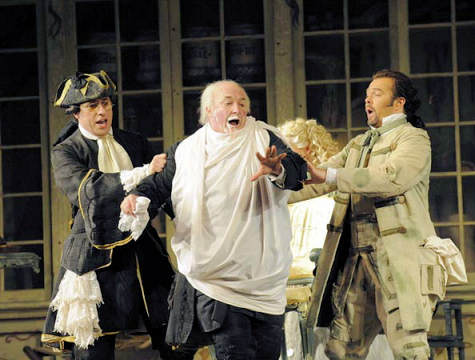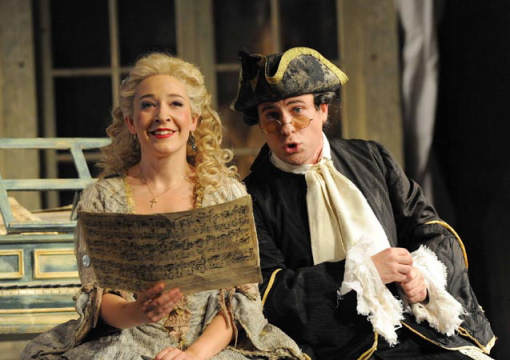Other Links
Editorial Board
- Editor - Bill Kenny
- London Editor-Melanie Eskenazi
- Founder - Len Mullenger
Google Site Search
SEEN
AND HEARD OPERA REVIEW
Rossini, The Barber of Seville:
Soloists,
Chorus and Orchestra of English National Opera. Conductor: Rory
Macdonald. The London Coliseum, London. 22.9.2008 (JPr)
Sir Jonathan Miller and English National Opera have been a
successful partnership since 1978 and his stagings of Rigoletto
and The Mikado have been two of the company’s greatest
successes over these past 30 years. This
is the tenth revival of his 1987 Barber and no doubt ENO
will be
hoping for similar longevity from his new staging of La bohème
to be seen early next year.

John Tessier (Almaviva) Andrew Shore (Bartolo)
and Garry Magee (Figaro)
With its controversial origins, who would
have believed that when
it was first performed in
1816, The Barber of Seville would become one of the
most loved operas of all time ? Why
controversial? Well, firstly it was
far from original. Beaumarchais' famous
play written in 1772 had already attracted
another composer, Giovanni Paisiello and his operatic version (1782)
was a great hit. (This is
very
similar to what happened with the Phantom of the Opera story
for which there were
other now-forgotten attempts at musical versions
of it before it brought Lloyd Webber
his great success.) When Paisiello's
admirers heard about Rossini's new work they caused a commotion at
its première - the opening performance did not go well and
things looked fairly
bleak for Rossini afterwards. In
the end however, his version soon surpassed Paisiello's
in popular appeal throughout Europe, with performances from London
to St Petersburg. In 1825 it was the first opera to be sung in
Italian in New York, and Rossini was arguably the most popular
composer in the world at the time.
As it happens, The Barber
of Seville can now feel like quite a modern
idea because today's cinema and television
audiences are more used to the idea of
‘prequels’ than people in the early nineteenth century
would have been. Beaumarchais'
original play had been followed by The Marriage of Figaro
in 1778 which resulted
of course in Mozart's wonderful opera
eight years later, featuring the continuing story of Rossini's
Barber characters .
Beaumarchais’ original drama was rather old-fashioned even in its
own time however, because his characters
have their roots in the commedia
dell’arte tradition dating back to
sixteenth-century Italy and still popular in much
of Europe two
hundred years later. Figaro, Count Almaviva in his soldier
disguise and Doctor Bartolo reflect the ‘stock’ characters of the
cunning servant, the braggart soldier and the
duped, doddery old man.
The opera also has the hoariest of plots
in which a pair of young lovers is united
after overcoming a number of obstacles.
Both for his contemporary audience, and for Rossini’s later success,
Beaumarchais filled out the characters to make them very
recognisably human and added
a subversive socio-political
theme: when the young Count goes to
Seville to pursue his heart’s desire, he not only leaves the Madrid
court and his family but also turns his back on a
proposed marriage arranged for him.
He woos his beloved Rosina, in
disguise to be sure that she accepts him
for himself and not his wealth or title. The
play affirms that in matters of love, we
are all equal and that true feelings - not
money or property - are the best
basis for marriage. In a small way, Beaumarchais
gave some voice to the rising revolutionary zeal of the 1780s which would
soon overwhelm a decaying aristocracy and
herald the Age of Enlightenment, the Romantic era and the rise of
democracy.

Anna
Grevelius
(Rosina) and John Tessier (Almaviva)
It is in fact 21 years ago since I saw
this production myself for the first and only time with the original
cast, including Alan Opie as Figaro and intriguingly
with Jane Eaglen as Berta. Although
Jonathan Miller was in the audience this time,
the revival was directed by
Ian
Rutherford. The dusty, slightly claustrophobic, ‘inside
of the house’ set where Rosina seems imprisoned has aged well – even
though it sounds a little arthritic when moved - and
it
continues to provide a restricted platform for the
plot's farcical events.
There are lots of sight gags; the ladder emerging from the trunk
brought on stage at the start by the Count’s performing troupe,
and the ducking and diving caused by Don Basilio’s large hat are
just two examples. The humour is anarchic, anti-authoritarian, a
little sardonic but rarely cruel. Pomposity may be deflated and
no-one suffers long-term harm as The Marriage of Figaro
shows. It is Rosina perhaps who
comes off worst but at the end of The Barber of Seville
she is yet to know that her marriage to
the Count will be a loveless one. Miller wraps up commedia
dell’arte, the Marx Brothers and the Whitehall Farce tradition to
give the audience an evening of unalloyed pleasure, insight and
subtlety of characterisation, extraordinary wit and good humour, as
well as huge amounts of humanity.
For me at least, the surtitles for
the opera in English proved unnecessary as the
balance between stage and orchestra, and
the fine ensemble cast that ENO have recruited
allowed all of Amanda and
Anthony Holden's translation to be heard
clearly. This varied from rhyming couplets such as ‘It’s time to
take a sounding / Ah,
how my heart is pounding’ to expositions
such as ‘Figaro has booked a lawyer to marry off his niece’ and
Doctor Bartolo’s response ‘He hasn’t got a niece’
-
which drew an
‘Ahh!’ from the audience to show how much they were wrapped up in the story.
With his rich voice, excellent diction and wonderful comic turn,
Andrew Shore’s Bartolo is at the very heart of the performance. It
is amazing to think that this most versatile singer was last month
singing Alberich at Bayreuth. His fussy physical humour and pained
expression of piqued pomposity reminded me
of Arthur Lowe in Dad’s Army. He imposed himself on
everything around him and
all eyes were
attracted to him whenever he was on stage.
Yet with a revival cast of such surprising depth,
Shore never seemed to unbalance the ensemble.
Making a notable British debut was the Canadian John Tessier, a
tenor who fearlessly attacked this high-lying role with much ease
and lyrical charm; the occasional moments
of strain in his top notes I put down to first night nerves. His
English suffers a little from a transatlantic drawl but he acted
well in his various guises and disguises. He reminds me very much of
another John, John Brecknock, an ENO stalwart of these type of roles
who sang the Count in the early 1980s.
The young conductor Rory Macdonald, a former Covent Garden Young
Artist working with ENO for the first time, delivers an account of
the score that is brimming with youthful energy, well-judged tempi
and not a little fizz and verve.
For all of its 192 years,
this staple of the operatic repertory complete
with the tongue-twisting Largo al
factotum and its
repeated
'Figaros' is
something that rarely disappoints. Here it
remains as witty, as often laugh-out-loud
funny, as touching and
as tuneful as it ever was.
Jim Pritchard
Pictures © Alastair Muir
Back
to Top
Cumulative Index Page
